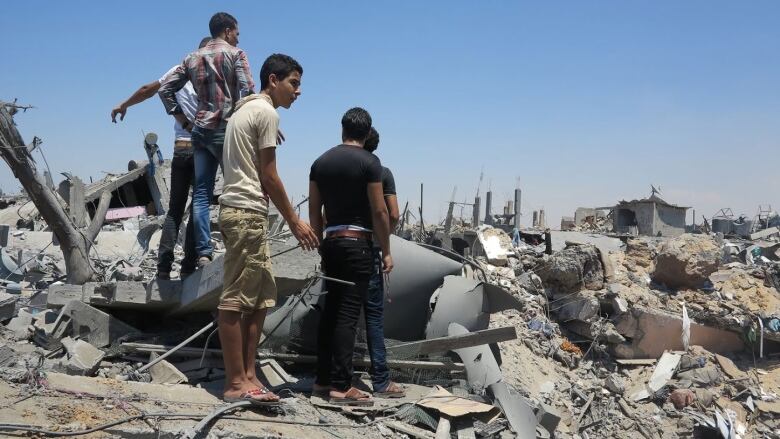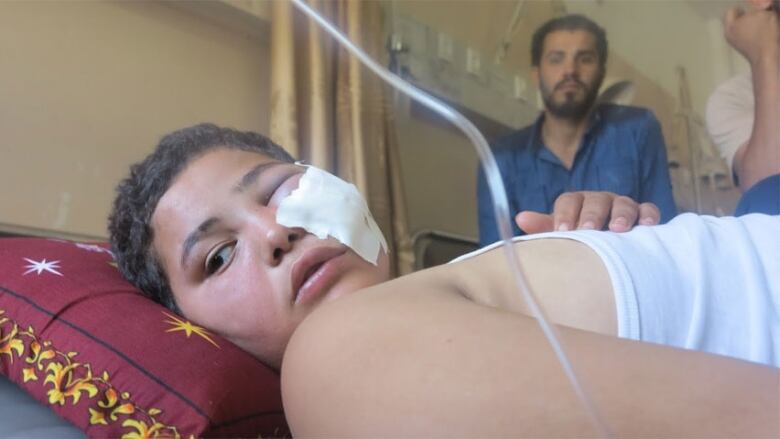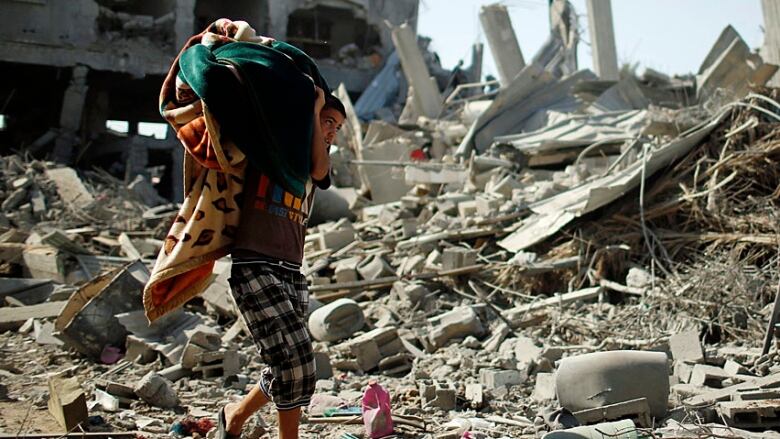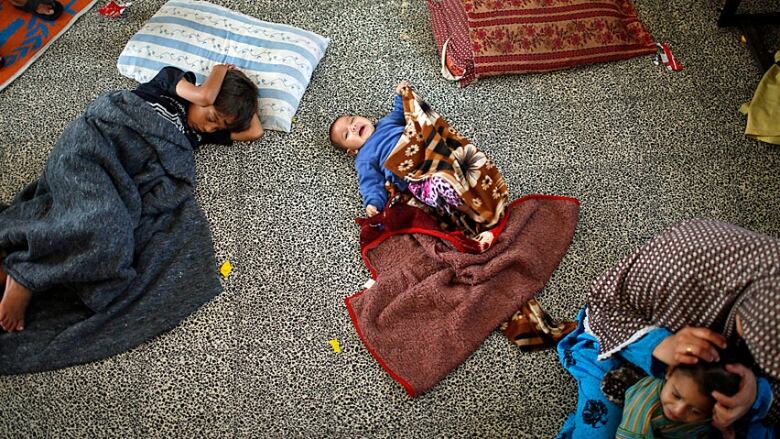Israel-Hamas conflict: Paul Hunter's 7 days in Gaza
'Being a correspondent in war zones puts you on a conveyor belt of fate'

We stood at the Erez border crossing, having cleared Israeli security, now just steps from the Gaza Strip.
Unfortunately none of the usually fearless Palestinian bus and taxi drivers who normally take journalists from the crossing point down into Gaza City regardless of the circumstances wanted to pick us up.

The roads, they said, were too dangerous.
The Israeli ground assault was happening just out the back door of the Erez Terminal. You could hear it. Sometimes the building shook. You could see tanks kicking up dust as they raced past the side windows.
Part of me thought it wouldn't be so bad if we couldn't get in. But we did.
CBC cameraman Samer Shalabi, a Palestinian with great contacts in Gaza, convinced a driver he knew to brave his way through the weaponry and pick up the roughly 50 of us who wanted in myself, Derek Stoffel and Marie-Eve Bdard and Sylvain Castonguay from Radio-Canada among them.
On word the bus was coming, we began the nearly two-kilometre walk through a caged walkway that leads to the bus pick-up zone. These are the first steps you take in Gaza. The trek gives you plenty of time to consider what you're heading into.
Plumes of smoke
A glance over either shoulder reveals active tanks in the sand dunes. Straight ahead on Gaza's horizon are plumes of black smoke. At the far end of the walkway sits a pile of rubble that had once been the Hamas border-crossing checkpoint until it was blown up.

We all wore helmets and heavy, ceramic-plated body armour. Along with our tripods, audio and video recorders, lights and editing gear, we each had medical kits we hoped we'd never have to use.
"This is nuts," I said to whoever could hear me.
I've often thought being a correspondent in war zones puts you on a conveyor belt of fate.
Once you decide to step onto it, the belt keeps you moving forward with no chance to get off until you reach its end. Whatever's going to happen is going to happen.
At the bus we quickly loaded our gear and jumped onboard. (It's worth noting our Palestinian bus driver had on only jeans, a plaid shirt and an over-the-top anxious expression.)
The door closed and we were off.

"A dead body!" someone shouted after about 10 seconds. Necks craned. We then passed craters, leveled buildings and dead farm animals.
Gaza is one of the more densely populated places on earth, but its streets near the border were empty. We heard more shelling, saw more plumes. Our driver observed no speed limit.
At the beach
Journalists in Gaza tend to stay at one of a handful of hotels along the beach. (Forget what you know about beaches, Gaza is not Daytona.) The appeal of these buildings is that the Israeli military knows we're in them, and in theory will aim to miss.
The downside to our hotel, as we learned, was that it's surrounded by well-known Hamas hot spots: residences, militant training grounds, weapons bunkers. All of them are in the Israeli crosshairs.
So shortly after we checked in to the hotel, an ear-splitting shriek ripped through our rooms, followed by the chest-thumping sound of an explosion.
An Israeli Hellfire missile had struck a penthouse apartment about 350 metres behind our hotel.
On hearing the blast, Derek and I opened our eighth-storey windows and stuck our heads out for a better look. As we stared at the scorch marks, a second missile flared past us about 50 metres out and exploded into the apartment next to the first one hit.
Clich alert: it seemed straight out of Hollywood. Except that my hands were shaking; it was that close.
Later, two more missiles about 500 metres on the other side of our hotel hit one of those weapons bunkers and a training field.
We hadn't even unpacked yet.
Those are the rules
The sound of war was loud and constant. Besides the missiles, there was the 24/7 hum of the drones. Fighter jets would periodically scream overhead. Tank fire blared almost all the time and every now and then war ships would speed in close to shore, fire a few rounds and speed back out to sea.
Hamas rockets (a loud screech fading to silence) would be followed by the distant double thump of the interceptions by Israel's Iron Dome anti-missile system.
The relentless noise (and the threat of death each thump represented) meant that at night, the slightest noise in your room made you jump and left you wide-eyed at 4 a.m.
Given all the threats, one tends to explore Gaza's streets with caution and planning. No one goes out simply to look around. You choose a destination, drive briskly and never stay long in any one place. Those are the rules.
On our first day, we went to Gaza's largest hospital, the al-Shifa. The injured arrive by ambulance, car and motorcycle.

One time I watched the crowd gasp as paramedics pulled a man out of an ambulance. His left leg had been blown off and was now a mangled red stump. I snapped photos blindly, unsure whether I'd ever use them, wishing I hadn't seen such bloody horror.
Inside, al-Shifa was a tsunami of misery. I didn't see a single empty bed. A grief-stricken family crowded around a woman in her 20s who had taken shrapnel in the head and was in a coma. She died a few days later.
I saw a young man unconscious and breathing with a respirator. But the mechanical respirator wasn't working, so his was a dirty tube coming out of his mouth attached to a large plastic bottle being squeezed and released by a young medical attendant.
With each hand pump, the boy's chest rose; with each release, it fell. How long could that possibly last, I wondered.
Another boy we met was hurt but able to speak to us from his bed. He told us the assault made him want to join Hamas. He was 13.
Sniper fire
We went twice to Shaja'ia, a suburb of Gaza City on its eastern edge. According to many, it's a beehive of Hamas.
The first time we went, as soon as we stepped out of our yellow minivan, we heard sniper fire from just around the corner. We kept away from open spaces, interviewed two people, videotaped a flattened mosque and left.
A few days later, during a humanitarian ceasefire, we returned to Shaja'ia and went deeper, toward where we'd heard that sniper. By then, the Israelis had flattened much of the place.
The destruction made me think of Port-au-Prince after the Haiti earthquake in 2010. It was jaw-droppingly complete.

And the landscape was monochrome. So much of Gaza is built from cinder block and concrete, which is why the rubble of Shaja'ia was uniformly grey.
Off to the side stood a man who'd lived near here. He couldn't say exactly where, because the destruction was so thorough he couldn't find where his house used to be.
I asked someone what he thought of all this and he told me his resolve to stand up to the Israelis had now hardened.
Once, while driving through Gaza, we saw a crowd of people grouped on the sidewalk. "Other way!" our translator shouted to our driver. "Other way!"
He told us a building near the crowd had just been targeted for an air strike. The Israelis often send warnings and people vacate. Some, it turns out, then stick around to watch.
At a United Nations school near Shaja'ia, 2,000 displaced Palestinians slept on classroom floors while flies crawled on their faces.
Kids drank from dirty water bottles, mothers feared disease and fathers pointed at their children, telling us, "These are not Hamas." No one knew when it would be safe to return home, or whether they'd even have a home to go back to.
There are many tens of thousands like them.
Getting out
After seven days of this, we decided to pull out of Gaza and regroup. But there was still the not-so-simple matter of driving back through those roads we'd taken into Palestinian territory.
A bus was organized for 9:30 a.m. on Sunday. Be there or you'll be left behind, we were told.
Winding our way through Gaza's warren of streets and laneways, we arrived at an intersection where the landscape opens up into a kind of countryside. From here, it's about six minutes to the Erez crossing.
We stopped and called the Israeli military to advise them that A Big Bus Filled With Journalists Was Headed Toward Their Tanks And Was Not a Threat So Please Don't Shoot.
This is normal practice. But there are never guarantees.
We sat for a while awaiting confirmation, only to learn the bad news: the fighting had increased and it was too intense for safe passage. We'd have to turn back.
So close.
Back downtown, we got a call a few hours later to say we could probably get through at 2 p.m., so once again, people began gathering near the bus.

Suddenly, there was a huge explosion about 200 metres from us. Children screamed and ran in all directions.
A much bigger blast to the north then followed. Biggest plume yet. Then we heard all kinds of blasts in the blocks around us. No one knew what was happening, but it felt as if the strikes were getting closer, so everyone ran to the bus.
We scrambled aboard and took off for the border without military approval. We'd try to get that en route.
The bus smelled of burnt explosive, but the emptied streets meant we could once again speed. And we did.
The shelling was constant. Plumes of smoke were on all sides. More scorched and smashed buildings.
When we got to the intersection where we'd earlier been turned back, Samer shouted at the driver, "Go, go, go, go, go!"
The further north we got, the hairier it seemed outside the bus. We started driving over small, blackened craters in the road, potholes from recent artillery fire or rockets.
At one point, something exploded about 40 metre in front and to our left. Thick, dark smoke rolled onto the road ahead, blinding us. We had to drive into it and through it or, we thought, face worse.
Gripping the arm rests, I worried about shards of window glass if they were to shatter. Not knowing what was beyond the smoke, I thought if we took a direct hit, at least it would all be over quickly. The conveyor belt of fate was speeding along, and we were still on it.
Finally, we got to Erez, bounded out of the bus, grabbed our gear and raced toward that long caged walkway.
As we walked toward the terminal, through the cage, we watched more tanks, armoured personnel carriers and tunnel busters kicking up dust as they rolled in.












_(720p).jpg)


 OFFICIAL HD MUSIC VIDEO.jpg)
.jpg)



























































































